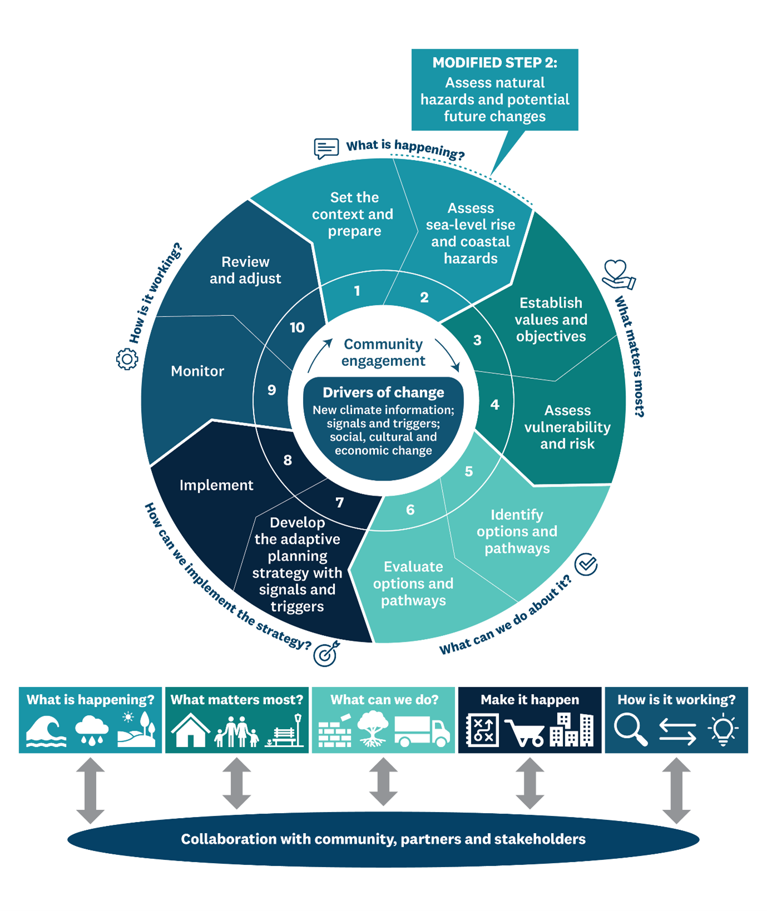-
-
-
-
-
Adaptation Programme
-
-
-
-
-
-
-
The Head of Lake Whakatipu natural hazards adaptation programme aims to build resilience to natural hazards and their risks including flooding, landslides and earthquakes as well as uncertainties such as landscape and climate change at the Head of Lake Whakatipu area including Glenorchy and Kinloch.
The setting at the Head of the Lake means we need to take a comprehensive approach to managing the hazards, one that takes a long-term view, encompasses all types of natural hazards, and works with the community to build resilience. Reactive or very localised responses are likely to only have shorter-term benefits (they can even result in negative outcomes in the future).
So, the most effective way to deal with this type of complex setting is to take a long-term, holistic adaptation view and work with the community and different partners to achieve this objective.
Otago Regional Council is taking the same approach in other areas facing complex challenges with natural hazards such as South Dunedin and the Clutha delta.
This work programme considers all types of natural hazards and their possible impacts – this includes hazards associated with floodplains and alluvial fans, such as flooding and erosion, along with seismic and geological hazards.
We expect that some hazards and their risks will change over time, and they may become more likely or have greater impacts due to changes in the landscape or climate or both. You can find out more about factors that are expected to increase the future flooding hazards for the Dart and Rees floodplains on our Investigations and reports page.
Managing these natural hazard challenges is a difficult challenge, and there are no simple solutions to address them, but we need to adapt now.
We have established a Head of Lake Whakatipu natural hazards adaptation programme. By working closely with the community, mana whenua, and partners on this programme, we can build resilience for the area now and in the future.

This programme uses an approach called Dynamic Adaptive Pathways Planning (also referred to as ‘DAPP’, or ‘Adaptation Pathways’).
This approach was developed by the Ministry for the Environment as a blueprint for community-led decision-making in areas affected by natural hazards and climate change.
This is a hazard management approach developed specifically to help plan and adapt for situations where the future is uncertain – it allows for flexible and adaptive decision-making, and for planning even when there may be uncertainty about the timing or impacts of future changes.
It’s also an approach that helps develop long-term responses to natural hazards affected by environmental changes. Other types of natural hazards, such as geological or seismic events like landsliding or liquefaction, will also be considered within this approach as part of the wider multi-hazard context.
This adaptation approach is often shown as a 10-step decision cycle and can be simplified as the sequence of five steps shown in the figure below.

The programme is led by the ORC Natural Hazards team. The team works closely with other ORC teams, Queenstown Lakes District Council, Civil Defence Emergency Management Otago, as well as with the community and mana whenua representatives.
The programme has delivered a range of significant outputs to date. These include:
- One natural hazards adaptation strategy for the Head of Lake Whakatipu area
- One flood modelling for Glenorchy
- One liquefaction hazard assessment
- Nine supporting studies on hydrological, geotechnical, and geomorphic conditions
- One social and economic impact assessment (two phases)
- One natural hazards risk assessment
- Five natural hazards mitigation studies
- One cultural values statement
- One mana whenua assessment of adaptation responses
- 18 community engagement activities
- 45 editions of a community newsletter
- One webpage for the programme
- Three environmental monitoring stations installed
- One flood forecast model developed and tested
The specific mix of natural hazards and physical processes in the head of Lake Wakatipu is unique to this area, but many other locations in Otago are exposed to the potential impacts of other combinations of natural hazard events.
ORC works to understand these hazards through hazard investigations and has a responsibility to manage hazard impacts through the development of adaptation or hazard management work programmes and long-term strategies.
This type of natural hazards adaptation management programme is a usual part of the ORC natural hazards work activities. ORC has previously completed, or has programmes underway or planned, to develop natural hazards management strategies for many locations within Otago, including:
- South Dunedin (the ‘South Dunedin Future’ project)
- Milton and the Tokomairiro Plain flooding hazards (the ‘Milton 2060’ project)
- Flood risk management strategy for the communities of Lake Wanaka and Wakatipu
- Balclutha and the Clutha Delta – river flooding and coastal hazards
- Water of Leith and Lindsay Creek (Dunedin City) flooding hazards
- Lower Taieri Plain flooding hazards
- Roxburgh debris flow hazards
- Middlemarch flooding and alluvial fan hazards


